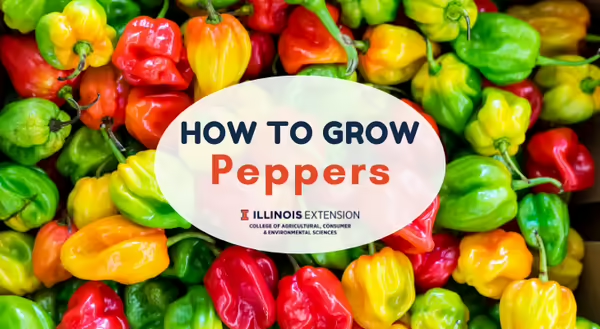
Peppers are a popular plant in the home garden. They come in a variety of different shapes, sizes, and heat. From the bright colors of sweet bell peppers to the face-melting heat of the Carolina Reaper, there is a pepper for any taste. In addition to their culinary uses, peppers can also make great additions to ornamental beds due to their bright colors.
Peppers (Capsicum spp.) are very-tender, warm-season perennial plants that we treat as annuals. Bell peppers are the most popular types of peppers grown in the U.S. However, hot peppers, sometimes referred to as chilies, have become increasingly popular. Hot peppers get their heat, or spiciness, from capsaicin. Contrary to popular belief, capsaicin is in the membrane (the white part) of the fruit, not in the seeds.
While most of the peppers grown in the home garden are different types of Capsicum annuum, there are actually five species of domesticated peppers.
|
Species |
Examples |
| C. annuum | Anaheim, Banana, Bell, Cayenne, Hungarian Wax, Jalapeno, Medusa, Poblano, and Serrano |
| C. baccatum | Bishop’s Crown, Lemon Drop |
| C. chinense | Carolina Reaper, Datil, Ghost Pepper, Habanero, Scotch Bonnet, and Trinidad Scorpion |
| C. frutescens | African Birdseye, Tobasco |
| C. pubescens | Canario, Rocoto |
Peppers are another of the Solanaceous crops (tomatoes, potatoes, eggplants). Compared to their tomato cousins, they like somewhat higher temperatures, grow more slowly and are smaller than most tomato plants. Like tomatoes, peppers are best started from seed or purchased as transplants.
Peppers don’t like cool, wet soils and will not tolerate frosts. Plants will grow poorly (yellow leaves, drop flowers) and slowly if temperatures are below 50-55ᵒF. Therefore, wait to plant your peppers until low are consistently in the 50s. Some people will lay black plastic mulch around their plants to warm the soil in the spring to avoid some of these issues. If you get your plants out too soon, you can cover them with floating row covers to protect them from cooler temperatures.
Like most other vegetable crops, peppers like well-drained, fertile soil. Plants are generally placed 18 to 24 inches apart. When transplanting peppers provide them with a starter fertilizer. Starter fertilizers are fertilizers that are high in phosphorous (10-50-10, 10-52-17, etc.). Typically, these fertilizers are diluted at a rate of 1 tablespoon per gallon of water, and one cup of the solution is applied to each plant. After your plants set their first peppers, you can side-dress with fertilizer (often ¼ lb. of 10-10-10 or equivalent per 10 ft. of row). Providing adequate, uniform moisture is also important when growing peppers, especially as the plants are producing fruit. Dry conditions can prevent fruit from setting (developing), or small, immature fruit may be aborted.
Peppers are afflicted with many of the same problems tomatoes are. Since they share many of the same problems, try to practice crop rotation. If you’ve grown tomatoes, or peppers, in an area previously and have had issues with insects and disease, try placing your peppers somewhere else in your garden. If you do have problems with diseases, or this is your first foray into growing peppers, try looking for varieties that have disease resistance.
Peppers can be harvested at any size. Green bell peppers are typically picked when they are mature (3-4 inches long, firm, and green). If you are growing colored types of bell peppers, wait until the fruits change color (red, yellow, orange, etc.). One way to tell if the fruit is mature is that they will easily break off of plants when picked. Hot peppers can also be picked at any stage but are typically picked when fully ripe (they are also at their hottest). The mature color of the fruit will vary on the variety, so do your homework and find out what they’re supposed to look like. Regardless of when you pick hot peppers wearing gloves may be helpful to prevent irritation to your skin, nose, and eyes. Additionally, if you’re cooking Carolina Reapers for hot sauce, do it outside and make sure you and your family are not standing downwind (it’s a long story).
Good Growing fact of the week: The Scoville scale was developed to measure the heat, or spiciness, of peppers. Bell peppers are a 0 on the scale, jalapenos are 2,500 – 8,000, and Carolina Reaper can reach 2.2 million!
Signup for our emails! Want to get notified when new Good Growing posts are available? SIGN ME UP
MEET THE AUTHOR
Ken Johnson is a Horticulture Educator with University of Illinois Extension, serving Calhoun, Cass, Greene, Morgan, and Scott counties since 2013. Ken provides horticulture programming with an emphasis on fruit and vegetable production, pest management, and beneficial insects. Through his programming, he aims to increase backyard food production and foster a greater appreciation of insects.